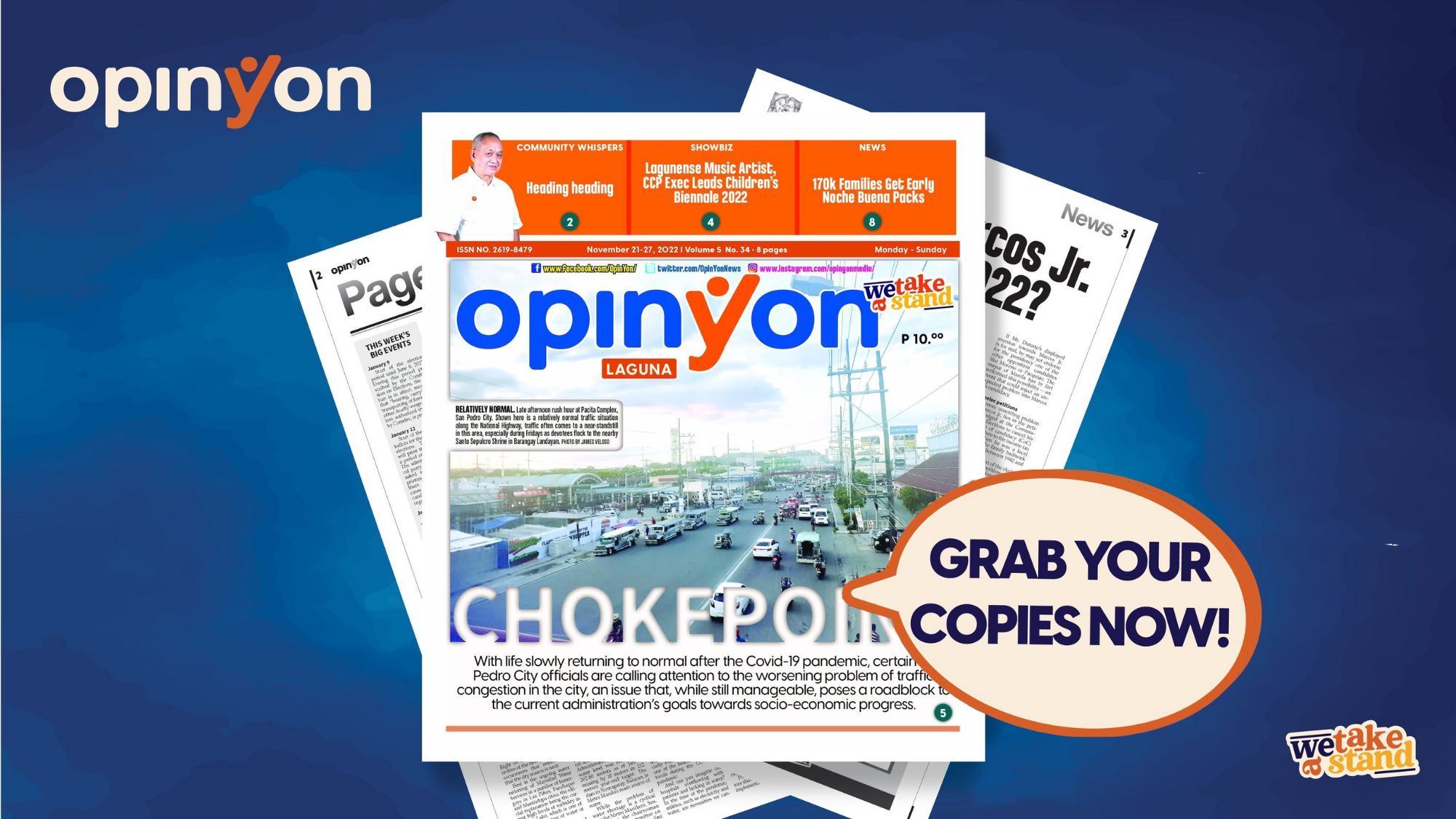With life slowly returning to normal after the Covid-19 pandemic, certain San Pedro City officials are calling attention to the worsening problem of traffic congestion in the city, an issue that, while still manageable, poses a roadblock to the current administration’s goals towards socio-economic progress.
The proximity of Laguna’s First District — San Pedro, Biñan and Sta. Rosa — to the National Capital Region has attracted those working in the metropolis who have found San Pedro City a perfect place to live and raise families.
This holds true, specifically in the late 1980s to the early 2000s, there was a boom in redevelopment of residential areas in these cities that attracted those who wish to escape the increasingly “hellish” problem of traffic congestion in Metro Manila.
Unfortunately, this rapid urbanization has brought the very same traffic snags over to Laguna’s First District.
We’re not just talking about the morning rush-hour traffic jams along the South Luzon Expressway (SLEX) that, in worst-case scenarios before the pandemic, extended up to Cabuyao City.
The growing concern lies in the increasing number of chokepoints or bottlenecks not just along the National Highway but also in secondary roads.
With the local economy on the way back to recovery after two years of the pandemic, some local officials in first district believe the traffic issue should be dealt with for residents to be spared the “carmaggedon” that has been constantly plaguing Metro Manila.
Critical Level
The worsening situation of heavy traffic in San Pedro City, for instance, has negative impact on its socio-economic progress, City Councilor Marky Oliveros claimed.
In his privilege speech during the regular Monday session of San Pedro City’s Sangguniang Panglungsod last November 14, Oliveros said the issue of traffic congestion in the has reached a “critical level.”
This chaotic traffic situation has “tremendously affected productivity, wasting precious time and resources and seriously affecting the health and well-being of our constituents,” the councilor added.
Oliveros, chairperson of the SP Committees on Peace and Order, Public Safety, Law and Ordinance, and Justice and Human Rights, said that with a population of 326,001 inhabitants based on the year 2020 census by the Philippine Statistics Authority and a road network of only 224.69 kilometers including national highways, city and barangay roads, flow of traffic is a major concern.
"The number of public utility vehicles within San Pedro is now 8,545 and the majority thereof is the tricycles with a total number of 7,288,” said Oliveros.
He also cited a study conducted by the city’s Public Order and Safety Office (POSO) that showed that there are around 10,000 vehicles of all types of vehicles passing San Pedro roadways daily.
Unfortunately, the pace of city road widening has not kept up with the rise in this number of vehicles.
“It shows that the city of San Pedro has become a chokepoint. Its residents effectively slowed down and immobilized by the sheer volume of vehicles and pedestrians passing within and through our city which is the ‘Una sa Laguna,’ a gateway to Calabarzon and the entry to Metro Manila,” Oliveros said.
Traditional Bottlenecks
San Pedro City traffic is not just felt along the National Highway but also in many secondary roads specifically in the barangays of Calendola, Magsaysay, Chrysanthemum, Rosario Village, Pacita 2, and San Vicente, as well as in Elvinda Village.
Already identified as “traditional chokepoints” such as portions of the National Highway at United San Pedro, the HBC area (near the city’s downtown area), and the area near Barangay Landayan and Robinsons Galleria South Mall, where traffic crawls to a near-standstill on Fridays due to the crowds of devotees at the Santo Sepulcro Shrine.
The main causes of traffic buildup in these areas, Public Order and Safety Office (POSO) head P/Col. Giovanni Martinez (Ret.), told OpinYon Laguna, is not just the rapid increase in traffic volume in the city but also construction works as well as apparent negligence of some barangay personnel in their duties to ensure a smooth traffic flow in their areas.
“May mga pagkakataon na iniiwan ng mga barangay police yung mga pwesto nila, so ang ginawa namin ay nagpatakbo kami ngayon ng enforcer sa taas [Upper Villages], imbes na yung enforcer na iyon ay dito lang sa baba,” Martinez said.
In a separate interview with OpinYon Laguna, Oliveros noted that the gradual reopening of business establishments after the restrictions brought by the pandemic are also a contributing factor in the worsening traffic situation in San Pedro City.
“Kung ano yung nararanasan natin noon na traffic before the pandemic ay mas lalong mararanasan natin ngayon yung bigat,” he explained. “And as we all know ang growth, ang pagdami is inevitable, di mapipigilan kaya nagkaroon ako ng pagkakataon na pag-aralan kung ilan na ba ang dumadaan natin na sasakyan dito, gano karami.”
Alternative Roads
One solution Oliveros sees to ease the city’s traffic burden is to request private subdivisions to allow the use of their streets as alternative passage.
He mentioned a proposed ordinance that will create a San Pedro City Alternative Route Bypass System (CARBS) by interconnecting subdivisions and other main thoroughfares, similar to the “Mabuhay Lanes” being implemented in Metro Manila.
“It is the right time to resort to an alternative way of lightening traffic congestion in our public roads by sorting networks of subdivisions or villages roads that can serve as an alternative route to de-clog our major issue of heavy traffic load,” he said.
Martinez said that some barangay officials have already coordinated with homeowners' associations (HOA) concerning the possible alternate thoroughfares.
"Alam ko po kasi, may mga area dito na donated na sa city government na tayo ang magme-maintain," he told OpinYon Laguna.
Martinez added that his office has requested the city government to set up meetings with barangay officials to coordinate with road-clearing operations, as well as deploying additional traffic personnel on roads that will be identified as alternate routes under the CARBS system. (With reports by Catherine Go and Jai Duena)
